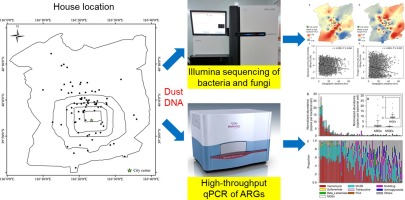当前位置:
X-MOL 学术
›
Environ. Int.
›
论文详情
Our official English website, www.x-mol.net, welcomes your
feedback! (Note: you will need to create a separate account there.)
Microbiome and antibiotic resistome in household dust from Beijing, China.
Environment International ( IF 10.3 ) Pub Date : 2020-04-02 , DOI: 10.1016/j.envint.2020.105702 Long-Jun Ding 1 , Xin-Yuan Zhou 2 , Yong-Guan Zhu 3
Environment International ( IF 10.3 ) Pub Date : 2020-04-02 , DOI: 10.1016/j.envint.2020.105702 Long-Jun Ding 1 , Xin-Yuan Zhou 2 , Yong-Guan Zhu 3
Affiliation

|
We spend ever-increasing time indoors along with urbanization; however, the geographical distribution patterns of microbiome and antibiotic resistome, and their driving forces in household environment remains poorly characterized. Here, we surveyed the bacterial and fungal communities, and the resistome in settled dust gathered from 82 homes located across Beijing, China, employing Illumina sequencing and high-throughput quantitative PCR techniques. There was no clear geographical distribution pattern in dust-related bacterial communities although a slight but significant (P < 0.05) distance-decay relationship occurred in its community similarity; by contrast, a relatively distinct geographical clustering and a stronger distance-decay relationship were observed in fungal communities at the local scale. The cross-domain (bacteria versus fungi) relationships in the microbiome of the dust samples were mostly observed as robust co-occurrence correlations. The bacterial communities were dominated by Proteobacteria and Actinobacteria phyla, with human skin, soil and plants being potential major sources. The fungal communities largely comprised potential allergens (a median 61% of the fungal sequences), with Alternaria genus within Ascomycota phylum being the most predominant taxa. The profile of dust-related bacterial communities was mainly affected by housing factors related to occupants and houseplants, while that of fungal communities was determined by georeferenced environmental factors, particularly vascular plant diversity. Additionally, a great diversity (1.96 on average for Shannon index) and normalized abundance (2.22 copies per bacterial cell on average) of antibiotic resistance genes were detected across the dust samples, with the dominance of genes resistant to vancomycin and Macrolide-Lincosamide-Streptogramin B. The resistome profile exhibited no distinct geographical pattern, and was primarily driven by certain bacterial phyla and occupancy-related factors. Overall, we underline the significance of anthropogenic impacts and house location in structuring bacterial and fungal communities inside homes, respectively, and suggest that household dust is an overlooked reservoir for antibiotic resistance.
更新日期:2020-04-03











































 京公网安备 11010802027423号
京公网安备 11010802027423号